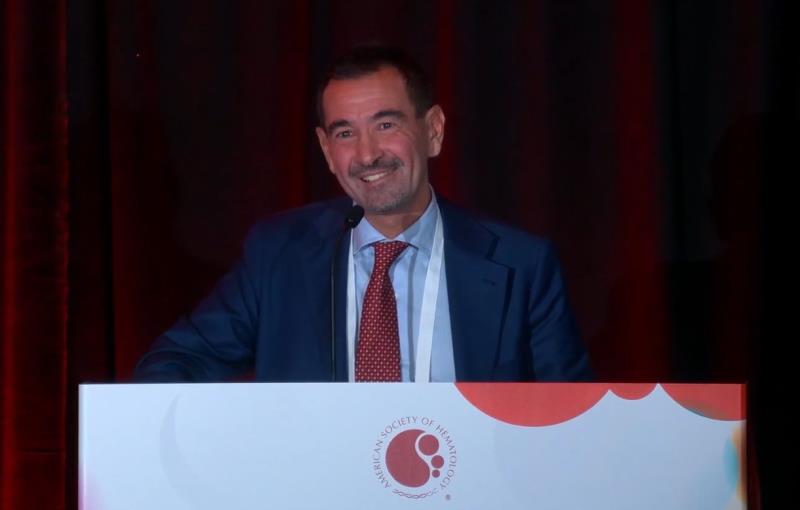Add-on eltrombopag RACEs to the frontline for aplastic anaemia treatment




 Dr Antonio Risitano from the EBMT, Leiden, Netherlands, discusses the findings of the final 2-year analysis of the EBMT-Saawp RACE study at ASH 2024.
Dr Antonio Risitano from the EBMT, Leiden, Netherlands, discusses the findings of the final 2-year analysis of the EBMT-Saawp RACE study at ASH 2024.In the final 2-year analysis of the EBMT-SAAWP* RACE** study, the addition of eltrombopag to standard immunosuppressive treatment (IST) comprising horse antithymocyte globulin (hATG) plus cyclosporin A (CsA) improves long-term outcomes as frontline therapy for severe aplastic anaemia/very severe aplastic anaemia (SAA/vSAA).
“IST is the standard treatment for [SAA]. Unfortunately, for about 20 years, we have been unable to improve treatment despite various attempts by adding another immunosuppressive agent or replacing ATG with more aggressive lymphodepleting agents,” said Dr Antonio Risitano from the EBMT, Leiden, the Netherlands, at ASH 2024. “But by serendipity more or less, the NIH*** was able to completely change the field by adding eltrombopag to hATG and CsA.”
“[Our study shows that] triple therapy with eltrombopag added to hATG and CsA provides a significantly higher haematologic response rate vs hATG and CsA alone at 24 months,” said Risitano.
At 24 months, complete response (CR) with triple therapy was 41.9 percent vs 30.3 percent with standard IST alone. This was a substantial improvement from that reported during the primary analysis at 3 months (21.9 percent vs 9.9 percent). A comparison between arms yielded an odds ratio (OR) of 1.94 (p=0.037) in favour of the former vs the latter.
The eltrombopag regimen also fared better than IST alone in terms of overall response (52.7 percent vs 36.4 percent; OR, 2.42; p=0.005). [ASH 2024, abstract 302]
Triple therapy was also better than IST alone in terms of timing of treatment as reflected by the first response (75.5 percent vs 48.7 percent; HR, 2.19; p=0.000) and first CR (62.4 percent vs 35.3 percent; HR, 1.82; p=0.000). “Basically, haematologic response was much faster in the investigational than the IST alone arm,” noted Risitano.
Factors that might have affected first response and first CR were age (40 years; HR, 0.77; p=0.037 and HR, 0.60; p=0.000, respectively) and disease severity (vSAA; HR, 0.51; p=0.003 and HR, 0.69; p=0.036).
Add-on eltrombopag achieved superiority over IST alone in terms of 2-year overall survival (OS; 91.4 percent vs 86 percent; HR, 0.54; p=0.064), disease-free survival (DFS; 54.7 percent vs 36.6 percent; HR, 0.50; p=0.000) and event-free survival (EFS; 48.4 percent vs 32.7 percent; HR, 0.54; p=0.000).
The cumulative incidence of relapse was comparable between triple therapy and IST alone (2-year estimate, 22.7 percent vs 18 percent; HR, 1.05; p=0.60). For IST discontinuation, the rate was lower with the former vs the latter (2-year estimate, 11.6 percent vs 25.3 percent; HR, 0.67; p=0.006).
The risk of clonal evolution remained negligible, with only three patients developing karyotypic abnormalities (two in the eltrombopag arm). The 2-year cumulative incidence of clinical paroxysmal nocturnal haemoglobinuria was lower in the investigational vs the comparator arm (1.1 percent vs 8.1 percent; HR, 0.12; p=0.000).
Half of the patients on IST alone required additional treatments, whereas with the experimental regimen, the corresponding rate is 38.5 percent.
First-line standard of care?
A total of 197 treatment-naïve patients were randomized 1:1 to standard IST (hATG 40 mg/kg for 4 days + CsA 5 mg/kg/day) alone or with eltrombopag 150 mg/day from day 14 until 6 months or 3 months in case of early CR.
Of the 22 deaths reported, eight were from the triple therapy arm (mostly due to infections). All deaths were due to SAA and its expected complications.
“[Our findings show] that improved rate and quality of haematological response resulting from the addition of eltrombopag to standard IST leads to improved 2-year OS, DFS, and EFS, in the absence of increased risk of secondary myeloid malignancies,” noted Risitano.
“These data support triple therapy with hATG, CsA, and eltrombopag as the current first-line standard of care for SAA/vSAA patients ineligible for transplantation,” Risitano concluded.
Results of the RACE-2 retrospective follow-up shall shed light on the long-term outcomes (up to 15 years) with triple therapy, including the evolution of the disease to myeloid neoplasms, and will ascertain its role as a disease-eradicating therapy for SAA/vSAA.